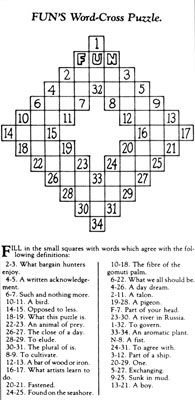

Born 21 December 1913. English reporter Arthur Wynne published in the New York World a new game called Word-cross, where traditional songs are mixed. Wynn himself confessed that he relied on the game of “magic squares” that his grandfather taught as a child to invent a new fun. In addition, games had previously been published similares.La children's magazine St. Nicholas published in 1873 word writing games in boxes. And in 1890, for Il Secolo Illustrato della Domenica, Giusseppe Airoldi prepared the game Per Passare il Tempo, which for the first time crossed vertical and horizontal definitions. But it was a simple and limited game, with four vertical words and four other horizontal words, and, of course, all words were of the same length, four letters.
Wynn, St. Thomas' Day of 1913, added an element that would decisively influence the game's success: the gaps that separated the words. Empty boxes allowed words of any length to be entered and the game expanded as much as you wanted.
I opened it. The New York World Wynn began to publish crosswords weekly, and other newspapers embarked on that path in just a few years. The Boston Globe, for example, began to offer readers cross-words in 1917. But the phenomenon erupted in the 1920s. In 1921, those in charge of the New York Public Library complained that “the madness of crosswords had hit libraries.” According to their own words, lovers of the new fashion monopolized the dictionaries and encyclopedias of the library and drove away the "real" users of the books.
In 1924, the publisher Simon and Schuster published his first book of crusaders. The fever had increased. Paradoxically, The New York Times, now famous for its crosswords, was at the forefront of the game crusade. In 1924, the newspaper said that the activity “had no effect on mental development.” The following year he stated: “Fortunately, the question of whether crosswords are beneficial or harmful does not need an answer. The frenzy is quickly turned off and in a few months it will be completely forgotten.” Those few months went by, even years, and although the full disappearance of fashion was published in 1929, Wynne's game continued. The tenacity of The New York Times lasted until 1942. It was then that they began to publish some of the most prestigious crosswords in the world, and some of the most difficult.
Robert Stilgenbauer was already preparing the most vast cross-words ever. He published ten years of work in 1949 and sold 125,000 copies. It has 3,185 vertical definitions and 3,149 horizontal definitions, and no one has completed it to date.